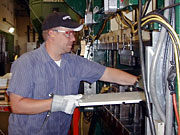Part 5: "I just pick myself up and get out there"
September 14, 2004
 |
| Evonne Russell is out looking for a job at a Workforce Center in St. Paul, two weeks after suddenly losing a long-time job at the post office. Fortunately she is already certified in a field for which there is some demand: nurse's assistant. (MPR Photo/Jeff Horwich) |
St. Paul, Minn. — The state's top labor analyst says one reason the going has been slow is that new hiring is partially cancelled out by continued job losses.
 | |||
"The pace of layoffs has remained inordinately high," says Steve Hine, employment analyst at the Minnesota Department of Employment and Economic Development. "We did see a dropping off as of April, but that level has ticked back up over the last few months. It's not low enough; we should see a drop-off of at least a couple thousand more a month before we can really use that as a guide to expectations of solid job growth."
This high rate of "churn" is a structural change in the economy that might make recovery in the job market harder to spot, and harder to feel.
One place to find both hope and despair on the job front is behind the computers at a Minnesota Workforce Center. At the Midway Workforce Center in St. Paul, the manager says the place has been busy lately. That's not necessarily a bad sign. It could mean discouraged workers are feeling good enough to come in and start looking again.
"I'm actually looking for customer service, or warehouse shipping and receiving, warehouse-type work," says Ted Ritter, who took time off after surgery in January and is now joining the search. Ritter says. He's not finding much he would consider "a long-term option."
What is a long-term option? "More companies doing direct hiring instead of utilizing temporary agencies and things like that," Ritter says. "The downfalls are: No benefits, and you're making less money than if you were directly hired because the temporary agency is making money off of you."
 | |||
Across the room, Benny Randle is looking for work in information systems management. He says there are more jobs than when he went through this process a few years ago. But there are also many more candidates.
"It is daunting at times, knowing that even though think you fit the skill there's probably somebody out there who's been working for 20 or 30 years and got laid off by a larger company, who's in the same boat," Randle says. "It's an employers' market, basically. They can pick and choose, and for most of us in this position it's a big cut in pay, too."
And Evonne Russell, sitting nearby, was caught off-guard two weeks before when cutbacks ended her six-year job at the post office. "Oh, God, it's like : OK, you really get in a panic situation, like, 'What are you going to do now?' It's really hard to say, because this is my first time ever being laid off from a job. It's like, OK, I've got bills, the mortgage is due, the car note is due, what is it I'm really going to do? So I just pick myself up and get out there and see what's out there. Hopefully I get a call real soon."
"Not getting no easier"
Not far from the Workforce Center, Charles Williams leans against a post by a freeway offramp, holding a sign: "Hungry, Need Work, God Bless."
Williams is looking to raise enough money to pay a solicitation fine and take a bus home to his family down south. Like everyone we've met in the past 20 minutes, he is in his own way a living barometer of the economic recovery.
 | |||
"Some days I have luck, and some days I don't do nothing," Williams says.
"I get work from here. A lot of people come by and pick me up and give me work from right here. I do landscaping, construction, carpentry, construction, asphalt; a little bit of everything."
Williams has revisited this off-ramp a number of times in the past eight months. Are people getting more generous?
"Less," he says. "It's getting worse. Not getting no easier, getting a little worse for me."
So...whose recovery is it?
There's no way to answer that question categorically, of course. But listen to the tone of voice. In the upper income brackets, it's not hard to find confidence in word and in deed. In certain economically sensitive sectors -- manufacturing, shipping, even massage -- people are wary, but tentatively declare a turnaround. For many individual workers, there is still a strong sense that better times are not right around the corner.
In the big picture, there's no doubt: The economy is growing. Technically, recovery is what economists call a "macroeconomic" concept -- think of it as looking down from outer space.
But recovery is also an individual, personal experience. And in many ways the view from the ground is far from clear.
|
News Headlines
|
Related Subjects
|

